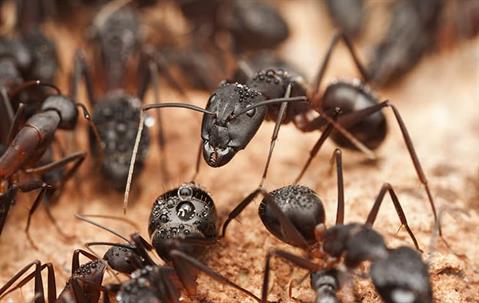Identifying Carpenter Ants
In some areas of the country, like here in Fort Gratiot, Michigan, carpenter ants cause more damage to structures than termites. It’s not hard to identify carpenter ants because of their size, they’re quite big. They range in size from 1/4 of an inch to a little over 1/2 inch with female alates (winged reproductive) being as big as 1 inch. They are difficult insects to control and can cause extensive damage to wood in a fairly short period of time. Carpenter ants do not actually eat wood, but excavate galleries within it to use as nesting sites.
Foraging Behaviors
Foraging activity can occur at any time of day, but usually peaks at night. Carpenter ants have good vision. When they’re not following chemical trails, they remember landmarks to help find their way. When foraging inside houses, Carpenter ants are attracted to sweets, meat, grease and fat. When Carpenter ants find food, they run back to the nest. Once in the nest, they communicate that they’ve found food, thus urging other ants to follow the chemical trail they laid down for them to follow.
Carpenter ants, like many other ants have knapsacks called crops. These crops are like carrying cases for them to carry food to take back to the colony. A carpenter ant colony is usually formed by a queen who establishes a nest in or around your home. In mature infestations, there may be as many as 10 satellite colonies linked to the parent colony by trails. There is a frequent exchange of workers between these satellite colonies and the main nest. Colonies normally do not produce winged reproductive forms until they are at least 2 to 4 years old, with typically occurring from May through July.
The female reproductive’s then swarm from the nesting site to establish new nests. The most common way in which homes become infested is through emigration of an existing colony. Houses located near wooded areas or brush covered vacant lots are good candidates for infestation. Carpenter ant colonies are inclined to move if they are disturbed, this often happens during construction or severe weather where nesting sites are disturbed.
Inspecting For Carpenter Ants
Some common signs of carpenter ant infestations:
Frass is made up of wood shavings, bits of soil, dead ants, and parts of insects. This material is often piled up outside of nest openings and found in spider webs and window sills.
Small windows or slit-like openings that Carpenter ants cut into infested wood. These windows are actually “garbage chutes” which are used to dispose of frass or unwanted materials.
Alates are the winged reproductives that take flight in the spring.
Worker Carpenter ants are more active at night, so you may not see any activity during normal working hours. Even if you do, it does not mean that the nest is nearby. Worker ants can travel up to 300 feet from their nesting site in search of food.
Clicking or rustling sounds can sometimes be heard coming from Carpenter ant nests. If you identify a potential nest site, try tapping against it with a screwdriver. You may hear a response — the clicking of alarmed ants.
Wood damaged by carpenter ants contains galleries that are very clean and smooth.
Carpenter ants normally excavate wood that has been softened by decay or other insects; however, they will tunnel into sound wood when conditions are favorable. Nests and galleries may be located a considerable distance from the point or points of entry. In addition to structural lumber, sites such as hollow-core doors, window headers, wall voids, and foam panels are particularly attractive to carpenter ants. Carpenter ants often enter homes through openings found in foundations, cracks, plumbing holes, cable connections, soffits, entrances for telephone and electric wires, etc.
Have trouble with carpenter ants or want to prevent these pests from getting in your home? Call now for a free quote on home pest control at (810) 216-5062.

